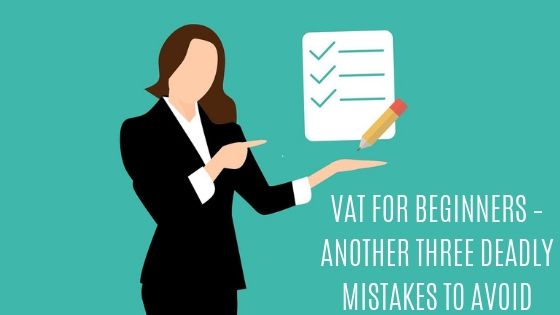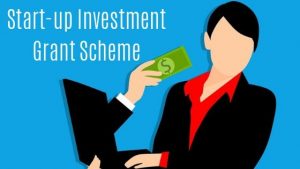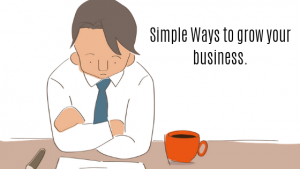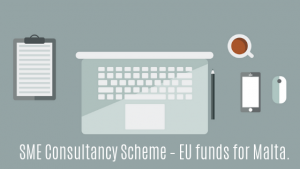1. Using VAT collected as a short term overdraft…. but not budgeting for Cash flow later on.
As mentioned before, VAT is not truly an expense for yourself. (Debateable if clients are consumers) It is collected from your client. As your role of an unofficial Tax Collector.
VAT is collected upfront (hopefully) and is payable later for periods covering either 3 months or 1 year later, depending on your reporting period. This timeframe from collection period to submission as you can see provides an opportunity. Think of this VAT as a very short term interest free overdraft or credit card which you can use for cash flow purposes.
And many business actually do use this, no Jedi mind tricks here. But what many do wrong is forget that this is owed to the VAT, and soon!
Make sure that you know exactly how much is owed for each month! Don’t wait for three months to pass!
With a good software or excel sheet if your starting out, this can easily be done. Budget for VAT, put this amount aside if necessary .Only use those funds if you’re certain you’ll be able to pay them back when your VAT is due.
Vat for beginners-another deadly mistakes to avoid
2. Having to pay VAT still not yet collected
Another one in Vat for beginners-another deadly mistakes to avoid
Not collecting your debts has never been scarier. Just look at the below example:
A client of yours, still owes you €1,180 for services rendered 4 months ago.
Yet an invoice by yourself has already been issued. By law (unless you fall under the Cash accounting scheme) even if you haven’t been paid by your client , you’re still obliged to issue an invoice. VAT is collected on invoices issued. It doesn’t make a difference whether the invoice has been paid or not by the client!
So this means that you owe the VAT department €180 (18% Vat on top of €1,000). Which is fine, had it not been for the fact you haven’t collected this €180 yet!
Not only have you not been paid your €1,180 and covered your business expenses for that service, BUT you also have to fork out from your pocket this money not yet collected to pay the €180 VAT due!
Goes without saying that this can be disastrous for your cash flow! It could also choke to death your business in the long run. Imagine the amount invoiced and not collected was €23,360 instead! Then you would have to fork out €3,600 (18% Vat on top of €20,000) . What if the sum is even greater than that!
Collect your debts. Remember a client is someone who pays you! If not, it’s doing work for free, and at a huge cost and loss!
3. Forgetting that VAT on assets is payable back if you close your business
Thirdly in Vat for beginners-another deadly mistakes to avoid
Just starting out at times means investing in and buying lots of Assets. Such as equipment, furniture , signage and furbishing costs, computers etc…
Well the good news is you’re likely to get a huge fat VAT refund for the input VAT paid on the above assets. So far so good. No big deal.
But there is a catch….and here is where you get knifed in the back if you’re not properly advised.
The input VAT may be payable back to the VAT dept! If you close your business before 5 years or 20 years (depending on the asset) have passed or get rid of your asset!
Any asset amounting to €1,164 excluding VAT must be listed in the VAT box 30 as Capital Goods.
So what are “Capital goods”?
The VAT dept. classifies Capital goods as ““all tangible fixed assets which can be used on a long term basis as working tools or other means used for the carrying of an economic activity” with a value of over 1,165 Eur “
Which for VAT purposes have a life span of :
- 20 years in the case of Immovable Property (check out Art 31 a (2)
5 Years for all others
4. Proper details on any Tax Invoice
Sounds obvious, but it certainly isn’t as common! If you’re registered under ART10, you have the “divine” right to claim back most of the Input VAT charged.
Well this divine right only applies if your business details as well as VAT number are listed on the Invoice.
If you’re a sole trader, than your name (as this is your legal trading name for VAT and income tax purposes) should be on the invoice as well your VAT number. Very important to also include your VAT number unless you want to face the music later on!
Now if you’re buying consumables etc from and outlet such as an ironmongery, forget that they’re going to enter all your details on the “chit”. As more commonly than not, the cash registers only issue a “Chit”. But this does not excuse you from telling cashiers to include your VAT number in the chit , which they will be able to enter. Do this or forfeit your right to claim the VAT!
5. It is a Tax Invoice
To be valid for input VAT, your supplier must issue a “Tax Invoice”. You’ll notice this as the document will either have “Invoice” or “Tax Invoice” written somewhere. “Cash Sale” is also valid.
Though in reality, we come across every manner of documentation that business owners unknowingly enter in their records thinking them correct. Luckily for them, we bring them back to the fold.
So below are various type of documentation commonly found which are not valid Not Valid for VAT (and even as Income TAX deductions for that matter)
- Quotations – just inform you of the price supplier will charge you.
- Sales Orders – Just confirming you have made an order
- Statements – Just confirming what invoices are due to be paid
- Return Notes – Just confirms you returned something back
- Delivery Notes – Just confirms you received goods from supplier
- Debit Notes – normally is turned into a credit note
- Receipts – This is just a confirmation that you have made a payment of an invoice
- Proforma – request for payment. Invoice is issued after
- Remittance Advice – similar to receipt but explains what invoices have been paid and activity
Always ask for a Tax Invoice!
6. VAT Fiscal receipts do not count!
And lastly in Vat for beginners-another deadly mistakes to avoid . Horror of horrors…That’s right, they white/grey fiscal receipt expenses incurred for an ART10 person are technically NOT valid to claim back VAT.
Unknown to most , contrary to popular belief and what really happens in practice, the Grey Fiscal Receipt is only valid for Consumers (i.e people who do not have a vat number and therefore do not have a right to collect VAT) .
Businesses should only issue a VAT fiscal receipt to consumers. (Unless they have a VAT EXO (exemption) number, but this is for another article)
What concerns us is that a Tax Invoice should be provided on a B2B transaction (Business to Business Transaction)
Always ask for TAX Invoice and NEVER ACCEPT and Grey VAT Fiscal Receipt as this gives you no right to claim input VAT. Despite what anyone will tell you (we have also surprisingly had our fair share of accountants say otherwise! ) It’s all there in the VAT legislation. Call the VAT department if you still don’t believe. Despite what really happens in practice and how other business operate…we repeat – ask for a tax invoice. Just don’t wait till you receive an inspection to confirm this!
BONUS – Don’t get punished for a good deed!
The VAT Fiscal, again contrary to popular belief….is not to be given as a receipt indicating “Proof of Payment”. One of the worst things we’ve seen a business do is :
- Issue a Tax Invoice – so far so good
- Receive Payment from client – fantastic! One less debtor to worry about!
- Then issue a VAT Fiscal Receipt to acknowledge payment of the tax invoice – Opppsss
What the business has incorrectly but effectively just done… is Invoiced itself twice! Once with a tax invoice for B2B and second time with a Fiscal Receipt normally given to B2C!.
As a Fiscal receipt is not a receipt for proof of payment but rather the proper legal documentation (instead of a tax invoice) to be given to consumers for a product or service sold.
Do not do this. If you want to give receipts as proof of payment to customers, create your own receipt book but please do not use the VAT fiscal receipts!
But what does this mean?
Say in Year 1 you bought a piece of equipment worth €5,900 (€5,000 + €900 VAT)
It’s over €1,164 and classifies itself as a Tangible Asset. Therefore it must be declared in box 30 as Capital Goods.
You claimed the Input Vat of €900 in your first VAT return.
After 2 years you closed your business, before 5 years have passed.
For the VAT dept this means you’re 3 years short! You closed your business after 2 years.
Therefore you owe the VAT dept. the 3 years’ worth of the Asset’s input VAT claimed in your first VAT return, but not used for the remaining 3 years!
This amounts to €540 owed to VAT dept (€900 / 5 years x 3 years not used)
Watch out, the last thing you want is the VAT dept knocking on your door with a VAT bill you never expected but legally enforceable , after you closed your business!
Confused or need a second opinion on your VAT matters, get in touch with our VAT ninjas here




